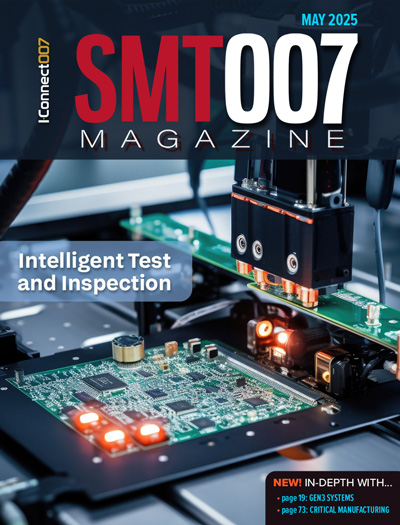-

- News
- Books
Featured Books
- smt007 Magazine
Latest Issues
Current Issue
What's Your Sweet Spot?
Are you in a niche that’s growing or shrinking? Is it time to reassess and refocus? We spotlight companies thriving by redefining or reinforcing their niche. What are their insights?

Moving Forward With Confidence
In this issue, we focus on sales and quoting, workforce training, new IPC leadership in the U.S. and Canada, the effects of tariffs, CFX standards, and much more—all designed to provide perspective as you move through the cloud bank of today's shifting economic market.

Intelligent Test and Inspection
Are you ready to explore the cutting-edge advancements shaping the electronics manufacturing industry? The May 2025 issue of SMT007 Magazine is packed with insights, innovations, and expert perspectives that you won’t want to miss.
- Articles
- Columns
- Links
- Media kit
||| MENU - smt007 Magazine
What SMT Component Shortages Mean for Design and Manufacturing Engineers
September 13, 2018 | Russell Poppe, JJS ManufacturingEstimated reading time: 4 minutes
Much has been written about the increasing shortages of multilayer ceramic capacitors (MLCC), surface mount (SMT) resistors and other semiconductor devices. Right now, we are seeing price increases and greatly extended lead times. In some cases, the delivery time is so long that the component is all but unavailable, and there has been a vast increase in devices notified as "end of life" and due for obsolescence.
Where components can be found, it is quite possible that they will be offered in smaller package sizes than before. According to a recent TTi MLCC Market update, manufacturers are migrating to smaller package sizes. We might find, for example, the popular 100nF capacitor soon only being available in 0201 or 01005 packages.
It seems the situation is likely to get rapidly worse rather than better. Given that product still needs to be manufactured and sold, it going to be down to design and manufacturing engineers to come up with solutions, and fast.
So, what are our options?
1. Can we fit smaller SMT components on PCB pads designed for larger devices?
Maybe. Unfortunately, there is no straight answer as it very much depends on the overall PCB design. The component size and the PCB pad design will determine how much of the device can sit on the pad and how good the solder joint can be. Standard sizes for components and pads or ‘land patterns’ are defined by IPC 7531, but for a variety of reasons designs can be slightly different, and maybe more or less favorable to using ‘wrong size’ components. As a worst case you might find something like the following for the smaller components:
If it does appear possible, it will probably be necessary to re-design the solder stencil. Careful stencil design, very accurate component placement and reflow profiling can reduce the risk of unwanted defects such as ‘tombstoning’. Without a change to the stencil aperture, the applied solder will try to ‘wet’ over the whole pad, which being too large for the device can pull it away from the pad.
It might be possible to get the PCB manufacturer to alter the solder resist to cover more of the pad, but again this can present printing problems.
Smaller components might also make it necessary to reduce the stencil thickness from say 5 to 4 thou. A ‘stepped’ stencil could be required to ensure the right amount of solder paste is applied to the right areas of the PCB, or perhaps use solder paste jetting instead of printing.
If you are looking to comply with IPC-A-610 standards, then you might find this approach is unsuitable. There could also be implications for longer term product reliability due to the solder joints being less than ideal.
Inspection and test also need considering. In particular, automated optical inspection (AOI) will need to be adjusted. First time pass yields are likely to decrease, and a larger amount of rework may be necessary.
Of course, when specifying alternative components their performance characteristics need to be correct too; smaller components may well have different operating voltages, heat dissipation etc. making them unsuitable for your circuit. ‘Track and gap’ requirements might need to be considered.
It is also worth checking that your SMT assembly equipment is capable of placing smaller components as 0402, or even larger, could be the limit for older equipment.
2. Can we re-design the PCB for smaller components?
Yes, and this is probably the preferred option, though much of the above still applies in terms of checking production capability, component characteristics and the need to amend stencils and inspection. Of course, testing and approvals processes will also need to be considered.
It might be possible to replace a few components with smaller parts, and keep the rest the same, by using a stepped stencil as discussed above. However, if the new smaller components are widely distributed across the PCB, decoupling capacitors for example, then a more extensive re-design might be required to ensure all components are small enough to use the same stencil thickness. Alternatively, it may be necessary to consider jet printing the solder paste.
If space allows, designing pads to accommodate two component sizes could help. This could be by having parallel components (with one not fitted) or by adjusting the pad size and gap; though of course consideration needs to be given to the solder joint that can achieved.
What should we do now?
In summary, the best approach is to discuss and evaluate what is possible with your manufacturing engineers before committing to any smaller components, as they will most probably raise some challenges—and costs—if indeed the parts are useable at all.
Ensuring the electrical integrity of the circuit is maintained is also vital, and, of course, any testing and/or approvals processes must be planned in.
Most important of all, though, is to start planning now. Your electronics manufacturing services (EMS) provider may have done a great job so far shielding you from this issue and securing stocks on behalf but there’s a limit to what they will be able to achieve as the months roll by without your input.
Suggested Items
Driving Innovation: Direct Imaging vs. Conventional Exposure
07/01/2025 | Simon Khesin -- Column: Driving InnovationMy first camera used Kodak film. I even experimented with developing photos in the bathroom, though I usually dropped the film off at a Kodak center and received the prints two weeks later, only to discover that some images were out of focus or poorly framed. Today, every smartphone contains a high-quality camera capable of producing stunning images instantly.
Hands-On Demos Now Available for Apollo Seiko’s EF and AF Selective Soldering Lines
06/30/2025 | Apollo SeikoApollo Seiko, a leading innovator in soldering technology, is excited to spotlight its expanded lineup of EF and AF Series Selective Soldering Systems, now available for live demonstrations in its newly dedicated demo room.
Indium Corporation Expert to Present on Automotive and Industrial Solder Bonding Solutions at Global Electronics Association Workshop
06/26/2025 | IndiumIndium Corporation Principal Engineer, Advanced Materials, Andy Mackie, Ph.D., MSc, will deliver a technical presentation on innovative solder bonding solutions for automotive and industrial applications at the Global Electronics A
Fresh PCB Concepts: Assembly Challenges with Micro Components and Standard Solder Mask Practices
06/26/2025 | Team NCAB -- Column: Fresh PCB ConceptsMicro components have redefined what is possible in PCB design. With package sizes like 01005 and 0201 becoming more common in high-density layouts, designers are now expected to pack more performance into smaller spaces than ever before. While these advancements support miniaturization and functionality, they introduce new assembly challenges, particularly with traditional solder mask and legend application processes.
Knocking Down the Bone Pile: Tin Whisker Mitigation in Aerospace Applications, Part 3
06/25/2025 | Nash Bell -- Column: Knocking Down the Bone PileTin whiskers are slender, hair-like metallic growths that can develop on the surface of tin-plated electronic components. Typically measuring a few micrometers in diameter and growing several millimeters in length, they form through an electrochemical process influenced by environmental factors such as temperature variations, mechanical or compressive stress, and the aging of solder alloys.


